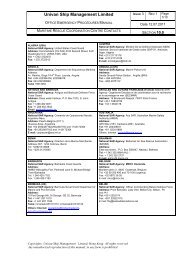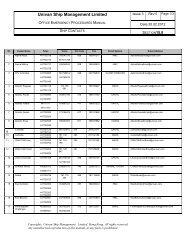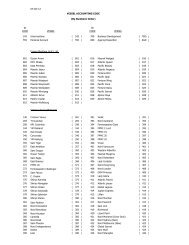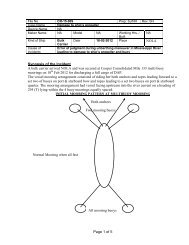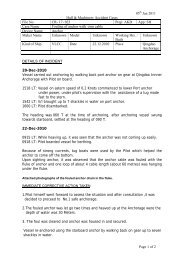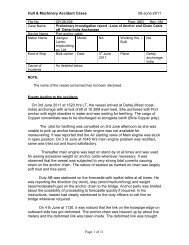Section: 11 CARGO OPERATIONS - Univan
Section: 11 CARGO OPERATIONS - Univan
Section: 11 CARGO OPERATIONS - Univan
Create successful ePaper yourself
Turn your PDF publications into a flip-book with our unique Google optimized e-Paper software.
<strong>Univan</strong> Ship Management Limited Issue 1 REV 0 Page<br />
2/8<br />
FLEET OPERATION MANUAL Date 01.01.2005<br />
SECURING OF CONTAINERS<br />
Copyrights: <strong>Univan</strong> Ship Management Limited, Hong Kong. All rights reserved<br />
Any unauthorized reproduction of this manual, in any form is prohibited<br />
SECTION <strong>11</strong>.9<br />
9. Welded devices should be used in preference to timber chocking. All welding to be inspected<br />
prior to the device being used. Where timber chocking is the only alternative, it should be<br />
properly secured within itself using nails, wedges, bolts, etc.<br />
10. Securing points must provide effective leads in terms of the axes of the forces being resisted,<br />
and be so arranged to avoid chafing. The securing points must not be overloaded by holding<br />
more lashings than they can safely take, and if necessary additional points are to be welded.<br />
<strong>11</strong>. A proper assessment of the forecasted and possible weather conditions should be made<br />
before the vessel sails and the securing arrangement should reflect the worst expected<br />
weather. Similar assessments should be conducted at appropriate intervals during the<br />
voyage. The vessel should be routed, if possible, to avoid rough weather, and courses and<br />
speeds should be adjusted to avoid excessive rolling and water on deck. Stabilisers should<br />
be used if fitted. Extra securing may be necessary during the voyage, weather permitting, in<br />
cases where the worst expected forces are likely to be/have been exceeded.<br />
12. Stability must be adequate for the whole voyage and must conform to Classification Society<br />
lashing plan conditions. Excessive stability should be avoided as this often subjects deck<br />
cargoes and their securing to greater forces than is necessary.<br />
Most problems arise with containers loaded on deck, and this is not surprising as under-deck<br />
stowage is often in cell guides. Deck cargoes are exposed to the elements and greater transverse<br />
forces, and there are numerous things required of the carrier if deck carriage is to be successful<br />
(which also means there are numerous things that can go wrong).<br />
Apart from deck stowage being the most common factor involved with shifting containers, the<br />
consequences of shifting on deck can be particularly wide ranging and costly. Damage may be<br />
caused to the shifted container or other units contacted, and where this involves toppling from a<br />
stack, damage may be extreme. This may be particularly critical if a reefer or tank container is<br />
involved. Where adjacent units are affected, a domino effect can result in a number of containers<br />
shifting and even being lost overboard. If numerous containers are lost the vessel may be caused<br />
to list and this could lead to further shifting as well as stability problems. Invariably the contents of<br />
lost containers will be a total loss, and added to the cost of this is the likelihood that the<br />
shipowner may be required by the State, whose waters may be affected, to carry out search and<br />
recovery (or at least pay for it). The contents of containers may also cause harm to the<br />
environment and this may lead to claims for damage to property and/or resources. State penalties<br />
and fines may be imposed.<br />
There are numerous factors involved with the shifting of containers carried on deck and this<br />
section attempts to identify and discuss these.<br />
<strong>11</strong>.9.2 Defective securing devices<br />
Very often the proximate cause of containers shifting is a defect in the securing devices<br />
themselves. Securing devices invariably receive some fairly rough treatment, and this can result<br />
in metal fatigue, fractures, breakage, excessive wearing, distortion or other damage. Rust will<br />
readily form under the conditions experienced at sea and this process of corrosion will accelerate<br />
the weakening process. Simple wearing can affect devices such as shoe twistlocks and base<br />
sockets to which the former fit. With such devices the edges/lips can become so worn that the<br />
twistlock can easily slip out or leave such a small degree of metal to metal contact that the excess<br />
clearance allows the containers to move. Once this momentum is started and excessive loading<br />
results, all other securing devices can quickly fail. Mechanical failure sometimes results from a<br />
manufacturing defect and more often than not this is associated with cheaply made devices.



